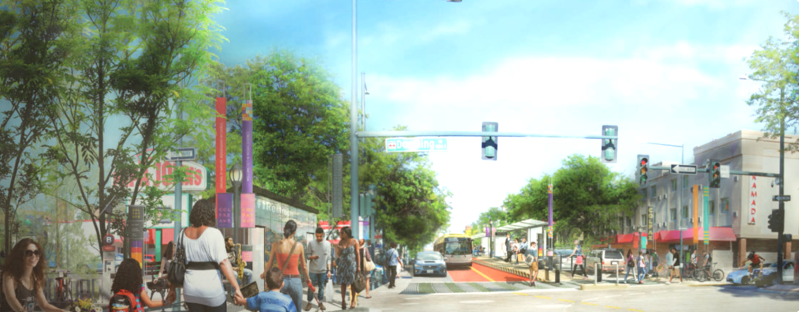Denver Public Works Unveils Plan for True Bus Rapid Transit on East Colfax Avenue
The new design is a major improvement over the previous plan and shows that good street-running transit is becoming a higher priority for the city.

The plan to upgrade transit on East Colfax Avenue has gone from ordinary bus lanes to true bus rapid transit.
Denver Public Works has revealed a design for dedicated transit lanes down the center of the city’s busiest bus corridor, a configuration that will be much less susceptible to blockage by illegally parked cars and other bus lane violators.
“Enhanced” stations will speed up service by letting riders pay before boarding and enter buses at any door. Traffic signals will give buses priority at intersections, meaning transit riders will hit more green lights and spend less time stopped at reds.
Buses will arrive every three to five minutes during peak hours, so riders won’t have to memorize schedules, and bus stops will display real-time arrival information.
Right now buses on Colfax move about 22,000 people daily, according to the project website. Because BRT vehicles won’t have to jockey for space with cars and will spend less time standing still at stops and intersections, service will be faster and gain capacity. Colfax BRT could move up to 50,000 passengers each day.
At those volumes, bus service would need to come more frequently than every three minutes, said Ryan Billings, a senior transportation planner with Denver Public Works. “When you’re trying to move 50,000 people in 2035, you’re gonna have some pretty crazy headways,” Billings said.
The city says Colfax BRT could be implemented as soon as 2020.

The new design for Colfax BRT is a signal that the Hancock administration is getting serious about changing the city’s cars-first streets and tackling Denver’s mobility challenges.
An earlier version of the project had bus lanes next to parking lanes, and they would only have been in effect during rush hours. That design would have been more prone to obstruction by cars, and would not deliver the same speed and reliability improvements as center-running bus lanes.
To make room for the center bus lanes and stations, one general traffic lane will be repurposed in each direction. That should have the further benefit of calming traffic and making crossings safer for pedestrians (along with curb extensions funded with money from the November bond package).
The center-running design will extend 5.7 miles from Broadway to Yosemite Street, though the Federal Transit Administration funded a study that covered I-25 to I-225. On each end of that stretch — a total of about four miles — there will be off-board fare collection and nicer bus stops, but no bus lanes.
The sections that aren’t slated for bus lanes are less congested, so they have less to gain from a dedicated right-of-way for transit. Still, a continuous busway would be better. If traffic on a section without dedicated lanes causes buses to bunch up, for instance, that will have a spillover effect on service “downstream” in the busiest part of Colfax.
One section without bus lanes is beyond Denver’s control. East of Yosemite Street, Colfax crosses into Aurora. “Aurora is very interested in improving transit on Colfax, but I think they’re in a little bit of a wait-and-see to see how some of the exclusive lane stuff works in Denver before they pull the trigger,” Billings said.
It’s also unclear how the bus lanes will be separated from traffic. The city may rely on paint alone to distinguish the bus lanes, or it may use some form of physical separation, Billings said.
Another question is whether Denver will buy a new bus fleet designed specifically for BRT. The vehicles on Colfax already have low floors, and the median bus stops will be built slightly above the grade of typical sidewalks, so boarding will be level, like on a train. That speeds up the process, but it could be even faster if the vehicles have bigger doors like the 16th Street Mall shuttle.
Some buses in RTD’s current Colfax fleet have two doors, Billings said. Buying a new fleet with more and bigger doors could cost between $50 million and $75 million, and the city would look into it if federal funding opens up, he said.
All told, the city’s new design for Colfax is great news for Denver, with big implications for bus service and pedestrian safety. The project could get a $55 million boost in November’s bond. Final design plans would be developed in 2018-19, and construction would start in 2020.
This article was changed to reflect the correct number of doors on buses in the Colfax fleet. DPW initially provided the reporter with the wrong number.


